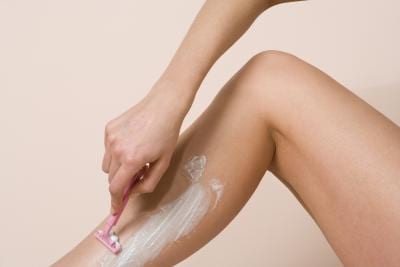Shaving is an inexpensive, efficient way to get rid of underarm and leg hair, but it comes at a cost. Shaving bumps — sometimes called “razor rash” — and ingrown hairs are typical hazards associated with this hair removal technique. Razor-irritated skin is difficult to treat, and many women may simply have to wait until body hair grows back out. The secret to preventing razor bumps is all in the tool you use and the way you shave.
Shaving Bumps and Ingrown Hairs
Nicks and cuts are only one problem associated with using a razor to remove hair. The drag of the razor on your skin is irritating, causing a rash of unsightly red shaving bumps to crop up after a shave. Skincare expert Paula Begoun indicates that ingrown hairs are also a troublesome side effect of shaving. These occur when hair curls around as it grows out, embedding itself in your skin and causing tiny pimple-like lesions. The common site of most razor bumps and ingrown hairs is your bikini line, where body hair is thicker, coarser and curly.
The Right Razor
Finding the right razor can be a matter of trial and error; what works wonders for others might not work at all for you. MayoClinic.Com indicates that a single-blade razor is the best choice if you want to avoid ingrown hairs. Dual- and triple-blade razors may contribute to razor bumps, but they also give you a closer shave — and silkier skin. Whichever shaving tool you choose, it’s important that you change the blade frequently, so it’s always sharp and new. Shaving with a dull razor is razor rash waiting to happen.
Prepping Your Skin
Get your skin ready for a shave by softening up the follicles first. Begoun and “Marie Claire” both recommend dampening your legs in the shower or bath for three minutes. Smooth on a lubricating shaving gel — avoid shaving gels that contain harsh ingredients, such as menthol or peppermint oil, which can make razor bumps worse. Even hair conditioner or your favorite body wash will do in a pinch.
Shaving Technique
When you apply the razor to your skin, don’t press down too hard — let the blade do the work for you. If you want a close, tight shave, draw the razor against hair growth, using your hand to draw your skin taut. However, be mindful that using this technique is more likely to cause ingrown hairs, cautions MayoClinic.com, which advocates shaving in the same direction as your hair grows and avoiding pulling on your skin. Dip your razor in water in between strokes.
Razor Bump Treatment
If you’ve taken all precautions and still get unbecoming shaving bumps, a topical treatment may help. According to Begoun, a topical post-shaving treatment that contains salicylic acid — stabilized aspirin — can sooth irritated skin. Ingrown hairs may require more diligent treatment. Begoun suggests using an over-the-counter cortisone or antibacterial cream to reduce inflammation and infection.
Other Choices
If shaving bumps and ingrown hairs continue to plague you, the American Osteopathic College of Dermatology offers other suggestions, such as using an electric razor. You may not get a close, sleek shave, but leaving body hair a little longer can reduce bumps and ingrown hairs. Using cream depilatories as a way to dissolve hair chemically is another option; however, these cannot be used on irritated skin, so it’s essential to wait until razor rash and ingrown hairs go away before applying these to your skin. If you can afford to splurge, the AOCD suggests considering more expensive long-term or permanent hair removal treatments, such as laser hair reduction or electrolysis.





